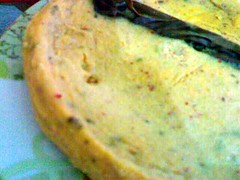The Margaritas that Sylvia and I ordered at the Matamoros restaurant (see the blog entry below) were served with a garnish of a green olive stuffed with a pimento.
Sylvia quickly plucked it from her drink’s rim and dropped it onto her cocktail napkin, took a sip of her Margarita and grimaced. But the problem wasn't the olive, the problem, she surmised, was that it was just too sweet. She doctored it with a bunch of lime wedges that were on the table, but she still couldn’t finish it. I thought there was something else strange in there, but the problem wasn’t the olive. Maybe it was just really bad tequila.
At any rate, we took the olive as a sign that the restaurant really didn’t understand Margaritas. We shrugged, got into her car and got in line to cross the border, emptying the contents of the bag we got at Las Palmas into our stomachs. Either the sugar or the fact that she was eating copious amounts of pastry and getting crumbs in her brother’s car after having eaten two lunches made Sylvia giddy. We were having fun.
But back to the Margarita mystery. For dinner we drove to South Padre Island to an old-school Tex-Mex place called The Palmetto Inn. I ordered enchiladas verdes and a Margarita, which came frozen. The garnish: a lime wedge and an olive on a skewer.

The Margarita was fine, but what was the olive doing there?
We finished off with a nightcap at Garcia’s, which was nearby. I ordered another Margarita, on the rocks.
It was garnished with three olives on a skewer.
“What’s up with the olives?” I asked the bartender, who told me it was a common garnish in Mexico, which of course it’s not.
Or is it?
My experience in Mexico is limited, but the Margaritas I had in the Los Mochis airport and throughout Sinaloa were free of olives.
The next day we drove to Houston and went to Sylvia’s restaurant (Sylvia’s Enchilada Kitchen) and she asked her cooks, who come from all over Mexico, about olives and Margaritas. None of them had ever seen olives in them.
Meanwhile I had a chelada and learned that American limes don’t seem to work as well in them as the milder Mexican ones — either that or the limes had been squeezed forcibly enough to extract some of the oil, adding extra lime flavor and bitterness. Also, the salt used to rim most Margarita glasses is too course for a chelada.
I ate eleven of Sylvia’s 18 varieties of enchiladas along with some tres leches cake, some chocolate tres leches cake (Sylvia’s invention) and some flan.
Today, after returning from Houston, well fed on migas and Sylvia’s signature pancakes, I e-mailed the listserv of the Association for the Study of Food and Society, the smartest people I know when it comes to foodways. Some responded accurately but unhelpfully that olives in Margaritas sounded gross. But they also speculated that the practice of adding olives might be isolated to the Lower Rio Grande Valley.
But Janet Chrzan cleverly found an entry in Wikipedia for a Mexican Martini:
This popular Texas cocktail consists of a large margarita (tequila-based) on the rocks, usually shaken and presented in the shaker, providing several servings poured by the drinker into a salt-rimmed cocktail glass with an olive garnish.
But it’s Wikipedia, and there’s nothing definitive about that.







